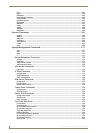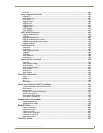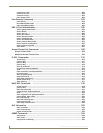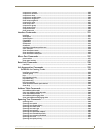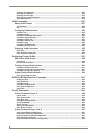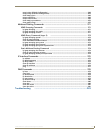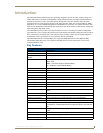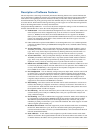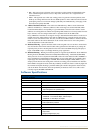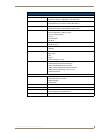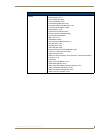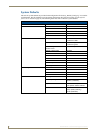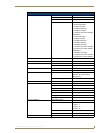
Introduction
2
NXA-ENET24 - Software Management Guide
Description of Software Features
The switch provides a wide range of advanced performance enhancing features. Flow control eliminates the
loss of packets due to bottlenecks caused by port saturation. Broadcast storm suppression prevents broadcast
traffic storms from engulfing the network. Port-based VLANs provide traffic security and efficient use of
network bandwidth. CoS priority queueing ensures the minimum delay for moving real-time multimedia data
across the network. While multicast filtering and routing provides support for real-time network applications.
Some of the management features are briefly described below.
Configuration Backup and Restore – You can save the current configuration settings to a file on a TFTP server,
and later download this file to restore the switch configuration settings.
Authentication – This switch authenticates management access via the console port or Telnet. User
names and passwords can be configured locally or can be verified via a remote authentication
server (i.e., RADIUS or TACACS+). Port-based authentication is also supported via the IEEE
802.1x protocol. This protocol uses the Extensible Authentication Protocol over LANs (EAPOL) to
request user credentials from the 802.1x client, and then verifies the client’s right to access the
network via an authentication server.
Other authentication options include SSH for secure management access over a Telnet-equivalent
connection, IP address filtering for SNMP/Telnet management access, and MAC address filtering
for port access.
Access Control Lists – ACLs provide packet filtering for IP frames (based on address, protocol,
TCP/UDP port number or TCP control code) or any frames (based on MAC address or Ethernet
type). ACLs can by used to improve performance by blocking unnecessary network traffic or to
implement security controls by restricting access to specific network resources or protocols.
Access Control Lists – ACLs provide packet filtering for IP frames (based on address, protocol,
TCP/UDP port number or TCP control code) or any frames (based on MAC address or Ethernet
type). ACLs can by used to improve performance by blocking unnecessary network traffic or to
implement security controls by restricting access to specific network resources or protocols.
DHCP Server and DHCP Relay – Since DHCP uses a broadcast mechanism, a DHCP server and
its client must physically reside on the same subnet. Since it is not practical to have a DHCP server
on every subnet, DHCP Relay is also supported to allow dynamic configuration of local clients
from a DHCP server located in a different network.
Port Configuration – You can manually configure the speed, duplex mode, and flow control used
on specific ports, or use auto-negotiation to detect the connection settings used by the attached
device. Use the full-duplex mode on ports whenever possible to double the throughput of switch
connections. Flow control should also be enabled to control network traffic during periods of
congestion and prevent the loss of packets when port buffer thresholds are exceeded. The switch
supports flow control based on the IEEE 802.3x standard.
Rate Limiting – This feature controls the maximum rate for traffic transmitted or received on an
interface. Rate limiting is configured on interfaces at the edge of a network to limit traffic into or
out of the network. Traffic that falls within the rate limit is transmitted, while packets that exceed
the acceptable amount of traffic are dropped.
Port Mirroring – The switch can unobtrusively mirror traffic from any port to a monitor port. You
can then attach a protocol analyzer or RMON probe to this port to perform traffic analysis and
verify connection integrity.
Port Trunking – Ports can be combined into an aggregate connection. Trunks can be manually set
up or dynamically configured using IEEE 802.3ad Link Aggregation Control Protocol (LACP).
The additional ports dramatically increase the throughput across any connection, and provide
redundancy by taking over the load if a port in the trunk should fail. The switch supports one trunk
with two Gigabit optional module ports.
Broadcast Storm Control – Broadcast suppression prevents broadcast traffic from overwhelming
the network. When enabled on a port, the level of broadcast traffic passing through the port is
restricted. If broadcast traffic rises above a pre-defined threshold, it will be throttled until the level
falls back beneath the threshold.
Static Addresses – A static address can be assigned to a specific interface on this switch. Static
addresses are bound to the assigned interface and will not be moved. When a static address is seen
on another interface, the address will be ignored and will not be written to the address table. Static



